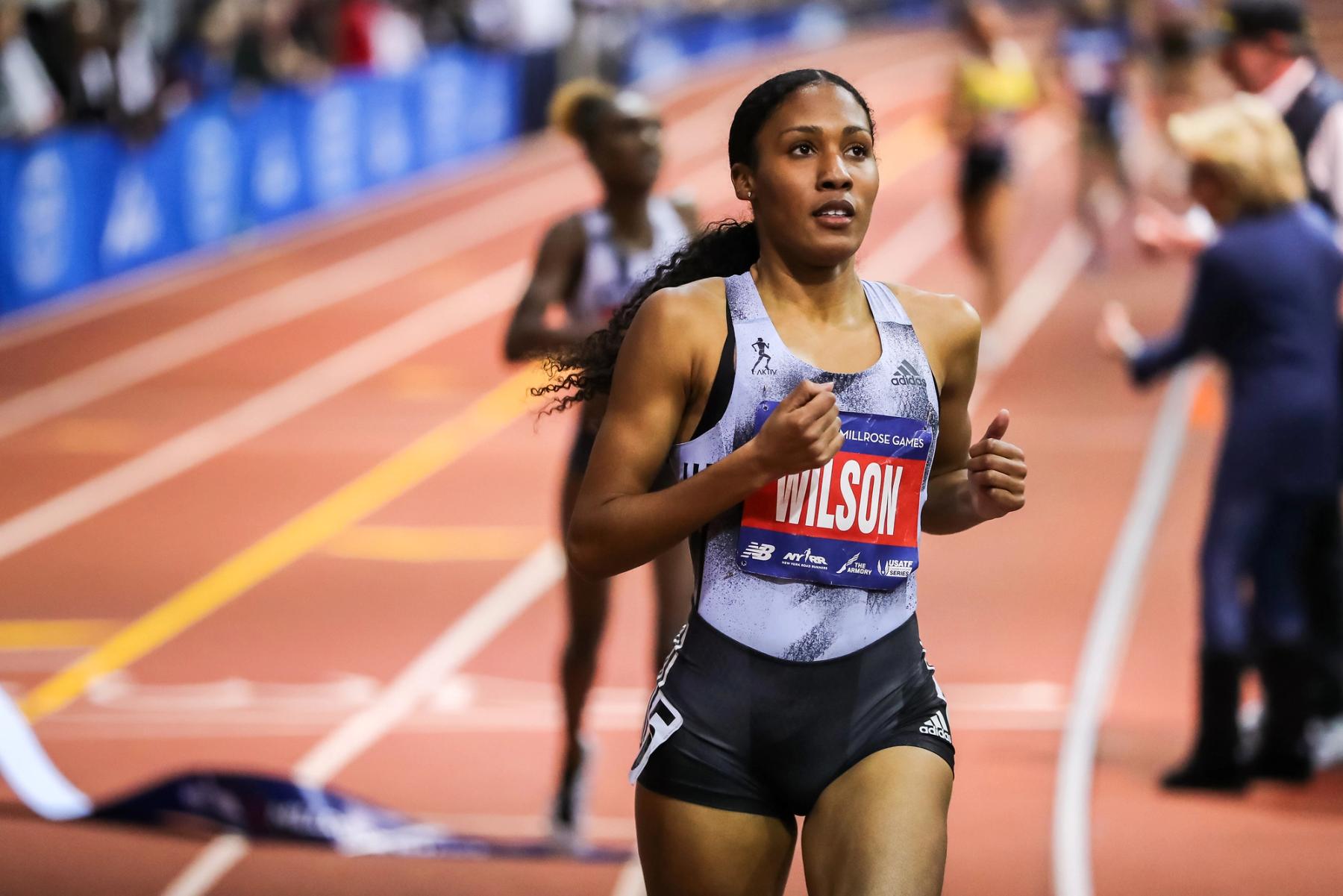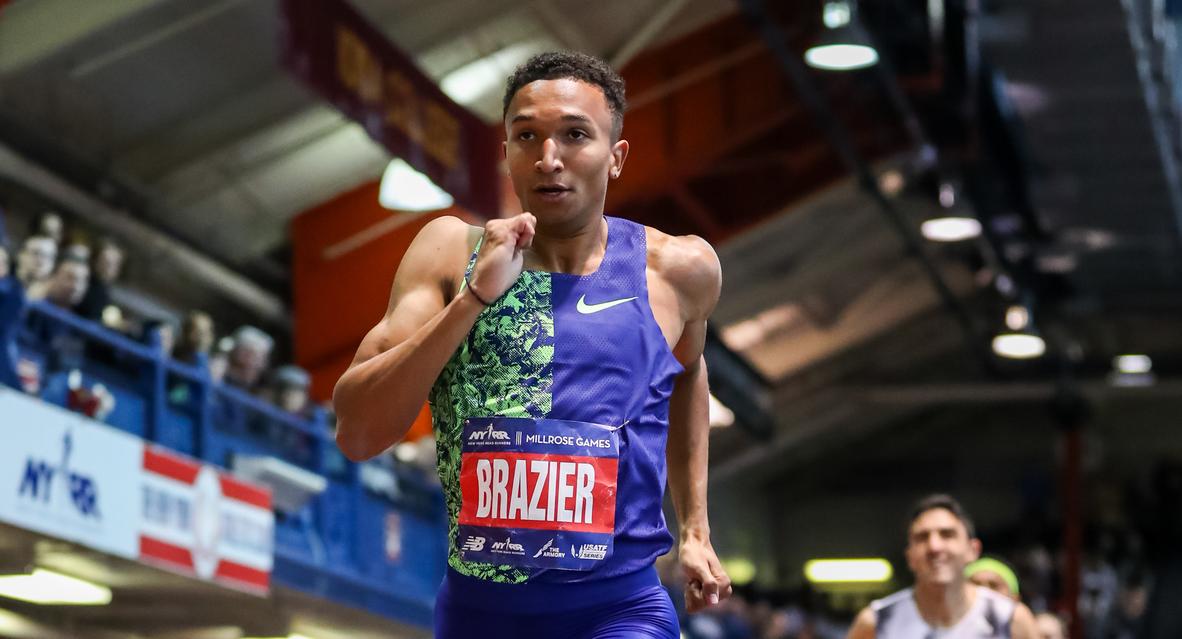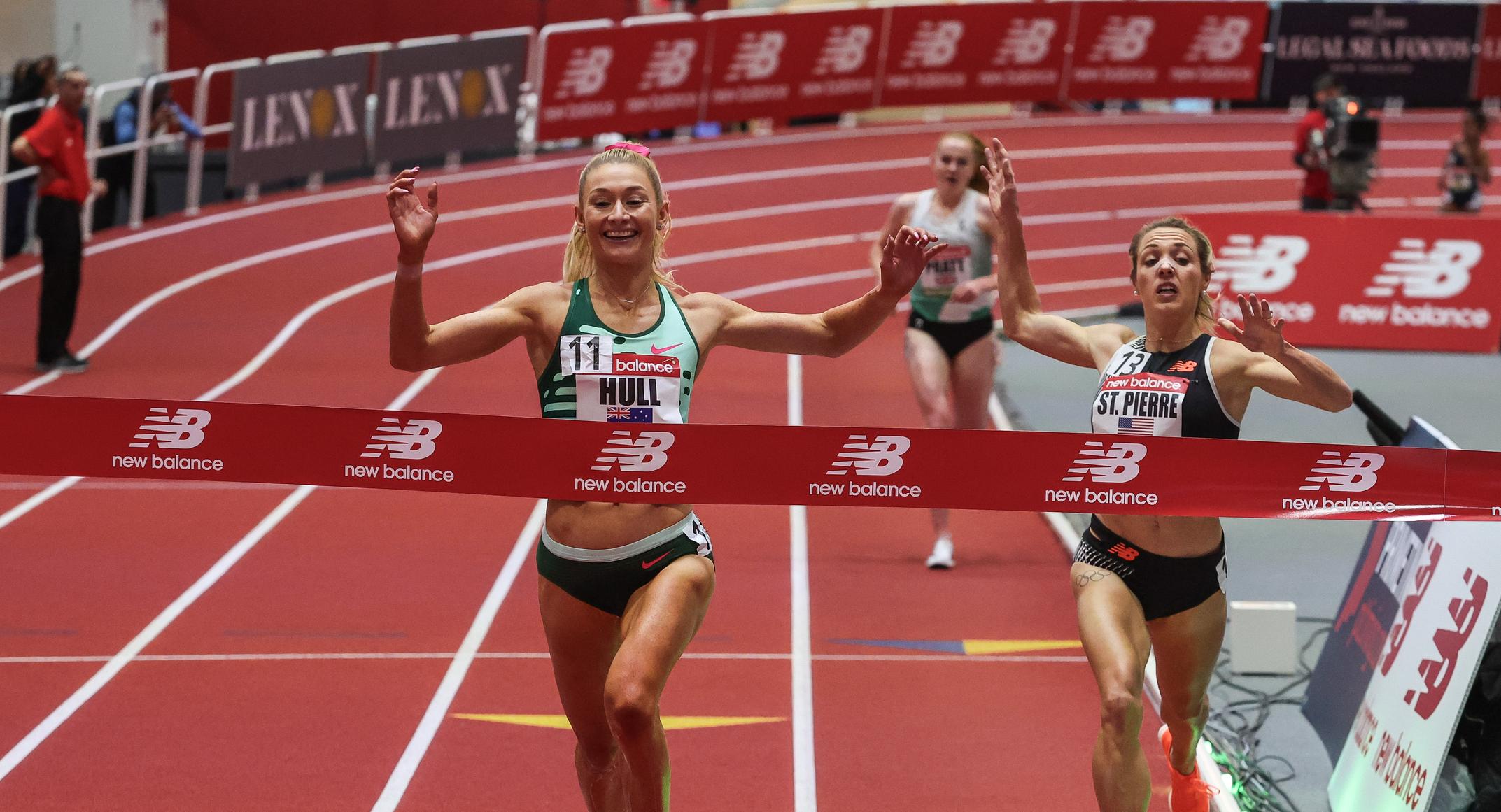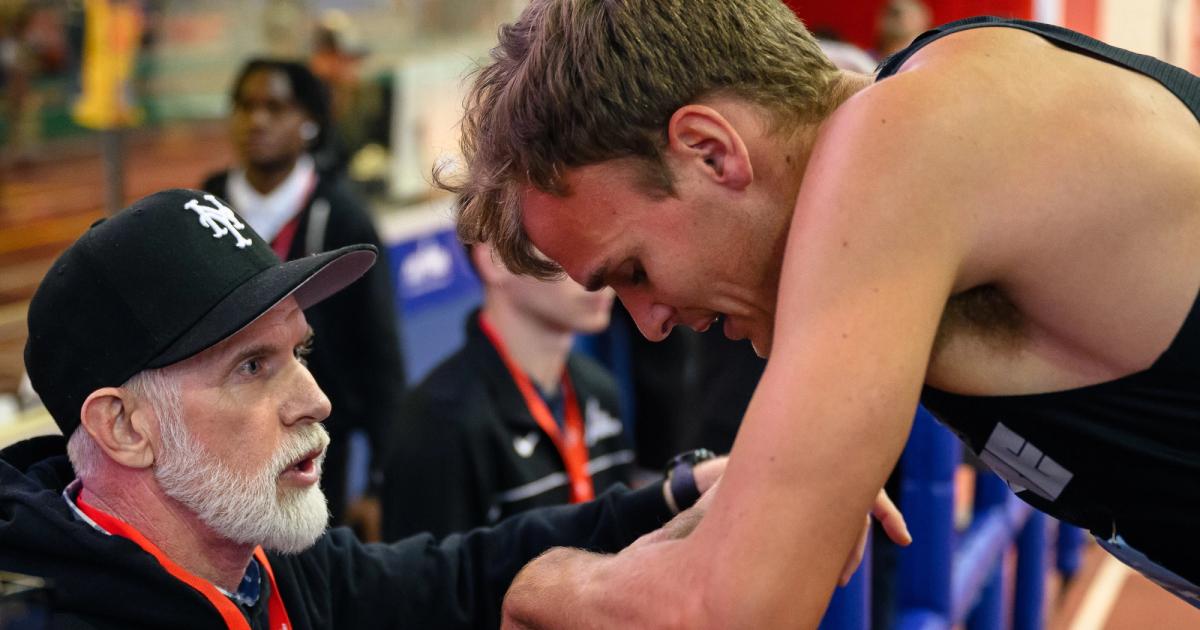By Owen Corbett
February 10, 2024
In honor of the 116th running of the Millrose Games, CITIUS MAG is listing the 116 best… no, we don't have time for that? Ok, then: the 10 best editions of the historic meet. Millrose has set the scene for countless indoor world records/bests and hosted numerous Olympic gold medalists, living up to its billing each and every year.
With the 2024 Millrose Games promising fireworks – the return of reigning Wanamaker champion Yared Nuguse, potential world record chases in both the men’s and women’s two miles, and a stacked high school contingent including indoor 200m record holder Adaejah Hodge – let’s take a look back at the best performances in Millrose history
2023: Near World Record In The Mile
We don’t have to look back very far for our first entry. Last year’s Millrose Games were an instant classic. World Athletics has a tool that scores meets annually with data going as far back as 2001, and of all the Millrose Games since the turn of the century, the 2023 edition (46,130 points) ranked far above the rest*.
The marquee event of the day, the Wanamaker Mile, more than lived up to its billing last year. Before his incredible outdoor season, On Athletics Club’s Yared Nuguse had one of the best indoor seasons we’ve ever seen from an American. Nuguse followed up a national record in the 3000m with a 3:47.38 Wanamaker win at the Armory, missing the world record by just .37 seconds. Behind Nuguse, Neil Gourley finished second, running 3:49.46, making it the second indoor race in history with multiple men under 3:50 (Yomif Kejelcha’s world record race is the other). Further down the deepest indoor mile ever run, the top six men all ran under 3:52 (no more than four had ever done so prior), and there were national records for Australia and Spain.
The men’s 3000m featured a stronger emphasis on the event than we have ever seen in New York, as 2023’s running brought the seven fastest times in the Armory’s history, national records for Guatemala, Switzerland, and New Zealand, and a near miss at the NCAA record. On the women’s side, the event provided an Armory/American record by Alicia Monson (No. 9 all-time), a collegiate record by Katelyn Tuohy, and a national record for Mexico.
Other highlights included the 300m American record by Abby Steiner (No. 3 all-time), a high school 60m record from Shawnti Jackson, a facility record in the shot put from Ryan Crouser (No. 6 all-time), and national records for Italy in the women’s mile and Mexico in the men’s 800m.
*the gap between 2023 and the second-highest scoring edition is larger than the gap between the second best and 11th best editions. 22 Millrose Games have been given competition scores
2020: Three American Records Fall
While many major meets were canceled in 2020, its early February slot on the calendar meant Millrose went off as planned (the 2021 meet did end up getting the axe, however). While 2020 ranks as only the fourth highest scoring edition of the Millrose Games since 2001, it may be the most memorable for American fans who witnessed their favorite athletes break a host of national records.
The women’s Wanamaker Mile overshadowed the men in 2020, as a 24-year-old Elle Purrier crushed the nearly four-decade-old American record, leading a number of top women to elite performances. Purrier blitzed past Konstanze Klosterhalfen at the tape, leaving the 22-year-old with the consolation prize of a German record. Behind the top two, Jemma Reekie set a British national record in third, followed by Gabriela Debues-Stafford and a new Canadian record in fourth. No other indoor mile in history has put multiple women under 4:20, and the four marks above ranked Nos. 2, 4, 5, and 9, all-time after the race.
The undercard to the greatest women’s Wanamaker Mile ever run was a pair of American records in the 800m. Fresh off a World Championship victory and an outdoor American record, Donovan Brazier ran the sixth fastest indoor time in history, while tri-state legend Ajeé Wilson ran the second fastest indoor 800m in a decade to break her own top U.S. mark.
In the 3000m, Newbury Park’s Nico Young broke the high school record on the men’s side, while the women’s race was decided by just .07 seconds, with Allie Ostrander taking the victory.

Kevin Morris / @KevMoFoto
2018: Two World Records
It speaks volumes about last year’s Millrose Games that the 2018 edition stands as the second highest scoring competition in the past 23 years of the meet, despite being the setting for two world records.
In each of the two years following her 2016 Olympic gold medal, Shaunae Miller-Uibo opened up her season running the 300m at the Millrose Games. She won the race in 2017 with a performance that placed her fourth on the all-time list at the distance – not too shabby. But she truly one-upped herself the following year, matching a world record that had stood for over a quarter of a century. Miller-Uibo must have convinced herself that she was pretty good at the distance, as she would smash the outdoor 300m world record the next year.
The other world record of the meet came in the women’s 4x800m relay, where Ajeé Wilson anchored a team of American stars with a blazing 1:58.37 final leg. Led off by Chrishuna Williams (2:05.10), a 21-year-old Raevyn Rogers (2:00.45) and Charlene Lipsey (2:01.98) contributed great legs, and the quartet broke the standing American record – that was set in 1987 – by nearly 20 seconds! Behind the world record run, two more teams registered top-10 all time marks in the self-titled NYC All-Stars** (No. 3, Kendra Chambers, Lynsey Sharp, Ce’Aira Brown, Cecilia Barowski) and a Jamaican squad anchored by Natoya Goule (No. 9). The race added some variety to the top of the event’s all-time list, which had Russian teams slotted in each of the top 14 spots prior to the meet.
While not every race produced a world record in 2018, other highlights from the meet include the third fastest indoor 800m of all time from Emmanuel Korir, a tight finish in the women’s Wanamaker Mile with Colleen Quigley outleaning Bowerman Track Club teammate Kate Grace by .03 seconds, and a meeting of future NC State Wolfpack teammates in the girls high school mile. The prep race featured the likes of Kelsey Chmiel, Marlee Starliper, Katelyn Tuohy, and Brooke Rabuer – but the win went to future Florida Gator Gabrielle Wilkinson
**the All-Stars mark is omitted from some top lists as they were a mixed nationality team with Sharp representing Great Britain

Kevin Morris / @KevMoFoto
2013: Three More American Records
The Millrose Games have always been one of the circled dates on the calendar during track and field’s long, cold winter, but during the 2000s the meet almost became predictable. Throughout that decade, there was something of a formula: meet directors put most of their money into providing a challenger to Bernard Lagat in the Wanamaker Mile. But the Kenyan-turned-American still bested Wanamaker rivals like Noah Ngeny, Kenenisa Bekele, Asbel Kiprop, Craig Mottram, Nick Willis, and Alan Webb. The races were tactical more often than not – six of Lagat’s eight wins were slower than 3:55, a time that 10 of the last 11 races have gone under – and featured a few big names but lacked depth as many years the race featured only five or six runners. The rest of the meet was not enough to draw in fans and attendance waned throughout the decade, forcing the meet to move to a smaller venue – more on that in a minute.
All of this is to say that the 2013 Millrose Games marked the return of the event to the top of the sport. It was the top-ranked indoor meet in the U.S. by World Athletics, and was a top five indoor meet in the world for the first time since the scoring system was established in 2001. Not coincidentally, Lagat was once again the biggest draw of the meet, but this time over twice the distance. The 38-year-old set an American and Millrose record over two miles running 8:09:72, 30 seconds ahead of a young Ed Cheserek, who broke a 49-year-old high school record at the distance.
A pair of American records also came in both the men’s and women’s 600m. The men’s mark, which was just three weeks old, fell at the hands of Erik Sowinski (before his career change to the most sought-after middle distance pacer on the planet), who ran the No. 5 time in history. The women’s race began as a world record chase, but Alysia Montaño settled for the second fastest mark all-time, giving her an American record for her troubles. Behind Montaño a high schooler by the name of Ajeé Wilson set the world junior record in second place.
Alongside all of these records, the Wanamaker Mile was far from an afterthought with the men’s race not only setting a meet record, but recording the three fastest times in Millrose history at the hands of Americans Lopez Lomong and Matthew Centrowitz, followed by Ireland’s Ciaran O’Lionaird. In fourth place, future Wanamaker champion Chris O’Hare had to settle for an NCAA record running for Tulsa.
Other highlights from the meet include another high school record, this one coming from Mary Cain in the girl’s mile, as well as a facility record in the women’s 60m hurdles.
2012: First Year In The Armory
Time for a history lesson, kids. As iconic as the Armory is, its role as host of the Millrose Games is a relatively new one. For more than 100 editions of Millrose, it was held in “the world’s most famous arena,” Madison Square Garden. The tightly banked, 146 meter track at the Garden was known more for its quirky distance (11 laps to a mile) than its speed. For most of the competition’s history, Millrose was able to sell out the roughly 18,000 seat Garden, but it hadn’t done so since 1997, highlighting the need for downsizing. Moving the meet to the Armory signified the beginning of a new era for Millrose, now with a capacity crowd of roughly 5,000, and an all-day Saturday schedule instead of its previous Friday evening format (this year’s edition is the first time in recent history the meet is being held on a Sunday).
Our own Kyle Merber, a native New Yorker who has run Millrose a number of times in the Armory, debuted at the meet in 2008 – taking home the win in the high school mile – before it left Midtown. “MSG was all about the match-ups and the prestige,” he said, “whereas the speed of the Armory has also made it an event to chase records.”
Nevertheless, Millrose has remained a marquee spot on the indoor calendar, and developed a legacy of its own at the Armory. “It doesn’t matter what building it happens in – if you run at the Millrose Games the pressure has always been consistent,” Merber said.
In 11 editions of the meet at the Armory, World Athletics has ranked Millrose as a top five indoor meet in the world seven times, and it has ranked number one in the U.S. five different times. These numbers far outpace the 11 MSG years since 2001, where the meet’s highest global rank was seventh, and it scored as the top domestic meet just once.
The Wanamaker Mile never fails to deliver, and the first eight-lap edition of the race was no different. 22-year-old Matt Centrowitz ran the second fastest time at the meet since 1991, and was the first American born runner to take the title since Steve Scott in 1984. Behind Centrowitz’s facility record, BYU senior Miles Batty set a collegiate record, starting a Millrose trend that would continue for the next two years.
The men’s 5000m was the race of the day, however, with eight-time Wanamaker champion Bernard Lagat stepping up in distance, and breaking in the Armory track with an American record that remains the fastest ever at Millrose. Finishing directly behind Lagat, Arizona teammates Lawi Lalang and Stephen Sambu both went under the collegiate record, with Lalang destroying Galen Rupp’s old mark by nearly 10 seconds. At the back of the race, future Oregon legend Ed Cheserek finished in eighth, breaking the national high school record, becoming the first prep runner to run under 14 minutes indoors. The 2012 Millrose Games were just the third indoor meet in history to put five men under 13:20, with the most recent prior occurrence happening just one day earlier in Germany. This was one of the last great 5000m races at Millrose, as the distance has only been contested twice since (in 2015 for the men and 2016 for the women).
Dueling in the women’s Wanamaker metric mile, Jenny Simpson edged Shannon Rowbury, whose fast times ranked them at No. 4 and No. 5 on the U.S. all-time indoor 1500m list respectively. As for some local future pros, 17-year-old Ajeé Wilson ran a 2:04 800m for fourth place in a pro field, and 16-year-old Eric Holt ran a 4:17 in the high school mile.
Other highlights from the meet include various facility records in the men’s high jump, as well as the women’s 60m hurdles, pole vault, long jump, and 400m – a performance by Sanya Richards-Ross that marked her fastest indoor 400m in eight years, and remains an Armory record.
2007: The Centennial
The Millrose Games are a truly historic meet. When the first edition ran back in 1908, Theodore Roosevelt was the U.S. president, there were only 46 U.S. states, and the fourth modern Olympiad had just been moved from Rome to London due to an eruption of Mt. Vesuvius. The Millrose Games have also been a model of consistency, running every year between January 14 and February 25th until the cancellation of the 2021 event due to COVID (Millrose was contested throughout WWII even when other historic competitions like Wimbledon, the Masters, and the Olympics were suspended).
The 2007 Millrose Games represented the 100th edition of the legendary meet, and fittingly drew a heaping amount of legendary athletes to New York. In the women’s pole vault, reigning Olympic and World Champion Yelena Isinbayeva went higher than any woman ever had on U.S. soil, before falling just short of her own world indoor record. Isinbayeva’s performance is even more impressive when you consider that she arrived in New York just the day before the competition, and was vaulting with the jetlag of a transcontinental flight in her system.
Perhaps the most fitting athlete to ring in the 100th celebration of the Millrose games was Bernard Lagat, who took home his fifth Wanamaker Mile title, and became the first American to win the race three straight years since 1971. Just behind Lagat, towering Aussie Craig Mottram ran the second fastest indoor mile in Australian history. Both runners beat Alan Webb just months before he would set the American record in the mile outdoors.
The most accomplished athlete to race at the centennial edition of Millrose however was three-time Olympic gold medalist and nine-time world champion Gail Devers. Devers, at age 40 and just a year and a half removed from giving birth, upset reigning Olympic champion Joanna Hayes. While Devers, still the meet record holder from three years prior, is not currently credited as the masters (40+) record holder in the event, her 7.86 clocking is well under the established record of 8.68. Devers stretched her incredible career longer than most sprinters do – she still holds the masters (35+) world records for the hurdles over 60m and 100m – but raced in only one more competition after her final Millrose win.
The number of stars at the meet made for a pole vault duel between the reigning indoor world champion, the reigning Commonwealth Games champion, and the American record holder in Brad Walker, Steve Hooker, and Jeff Hartwig, won by Walker. The men’s shot put was won by former indoor world champion Christian Cantwell, and the women’s 3000m was won by three-time world champion Tirunesh Dibaba, just six days after setting the all-time indoor 5000m mark in Boston.
1998: Debut of Women’s Pole Vault
While the hardwood track at Madison Square Garden may not have been renowned for its speed, the pole vault runway at Millrose’s first home was the site of countless history-making performances. The problem however, was that in the first 90 years of the Millrose Games, none of those performances were by women.
The Millrose Games have always prominently featured the men’s pole vault, and has been rewarded with five indoor world records in the discipline dating back to 1926, including the first indoor vaults over 15, 16, and 18 feet in history. The meet was even a big enough draw to attract Sergey Bubka – the greatest pole vaulter in history until Mondo Duplantis (who set a world indoor junior record at Millrose in 2017) – to the Garden in 1996, 10 years after his Millrose debut where he criticized the conditions, called out the officials, and temporarily withdrew from the competition before being persuaded to return.
After waiting nearly a century to get in on the vaulting, the women wasted no time making history. From February 2nd to March 26th of 1998, the women’s indoor pole vault world record was raised 11(!) times, and although Stacy Dragila fell short when attempting a world record height at the 91st Millrose Games amidst that stretch, she left a lasting impact on the New York crowd. Dragila first matched the world record in 1997, but by the end of 2003 she had tied or bettered either the indoor or outdoor pole vault record 15 times (11 of them coming between 2000 and 2001) and is the only American woman to hold either record since the World Athletics began ratifying records in the event in 1994. Dragila set the first ratified women’s pole vault records on U.S. soil in 2000, and followed them up with the first – and only – women’s pole vault world record at Millrose in 2001.
In the past quarter century, the women’s side of the event has blossomed at Millrose, attracting stars like Yelena Isinbayeva, the greatest women’s pole vaulter of all time. We have also seen star studded matchups like the 2022 showdown between Olympic Champ Katie Moon (Nageotte at the time) and American outdoor record holder Sandi Morris, two years after Morris set an incredible Millrose record by vaulting 4.91m.
Other highlights from the 1997 edition of the Millrose Games include Melissa Morrison running the fourth best 60m hurdles time in U.S. history and upsetting Jamaican record holder Michelle Freeman. On the men’s side we had a matchup between three of the four fastest men in 60m history, won by newly minted world record holder Maurice Greene, and a showdown between three of the five fastest Americans in history in the 60m hurdles, won by reigning Olympic champion Allen Johnson.
In the Wanamaker Mile, Laban Rotich became the second Kenyan to take home the title, and the first in over thirty years. In the undercard over the same distance, future Oregon and Washington coach Andy Powell won the high school mile in 4:16.
1981/1982: The Big Apple Gets The Biggest Stars
The 1981 Millrose Games has been dubbed by some as the “Greatest Indoor Track Meet Ever Held.” And its sequel wasn’t too shabby. The men’s 5000m in 1981 produced five of the eight fastest indoor times in history at the distance, highlighted by a world record from Tanzanian Suleiman Nyambui. In front of the University of Texas at El Paso junior – who was one week shy of his 28th birthday! – for the majority of the more than 34 lap race was New York City Marathon champion Alberto Salazar, who would have to settle for second place, an American record, and the third fastest time in history. Behind them in third place, Geoff Smith set a British record with the No. 5 all-time indoor performance. The following year’s race may have been even deeper, tallying six of the 12 fastest marks in the event’s history. Setting a new American record, Doug Padilla won the race just short of Nyambui’s time from the previous year. Once again Smith found himself in third place, and he ran a fast enough time to improve his British record, except for the fact that it was taken from him by second placed finisher Nick Rose, whose 13:21.27 put him fourth on the all-time list.
The 1981 Wanamaker Mile was nearly as deep as that year’s 5000m, with its top four finishing times ranking among the top-14 indoor mile performances in history. Eamonn “Chairman of the Boards” Colghan’s 3:53 was the fastest in meet history, stood as a Millrose record until 2005, and was just .4 seconds off a world record. Behind Colghan, fellow Irishman Ray Flynn (who became the Millrose meet director in 2012) ran the fastest non-winning time in the Wanamaker Mile until 2013 which was good for No. 6 all time. The race also saw a West German record and the first indoor occurrence in history of four men running sub-3:55 in the same race. Colghan’s win came amidst a stretch from 1977 to 1992 where Irishmen from Villanova won 12 of 16 titles in the Wanamaker Mile – call it Big East home track advantage***. The main attraction in the mile the following year was world record holder Mary Decker-Tabb, who smashed her own mark by more than three seconds. The record was Decker-Tabb’s second in a year where she set an astonishing six world records.
Other highlights from 1981 include a world record over 1000 yards by American Don Paige, an American record in the women’s high jump, a high school record in the 800m, and an appearance by multi-sport high school star Herschel Walker in the 60m dash.
Other major performances from 1982 include Candy Young, and Stephanie Hightower tying for the win – and a world record in the – 60 yard hurdles, and 20-year-old Carl Lewis with the fourth farthest long jump in history (second farthest indoors) two years before he would break the world indoor record at Millrose in the leadup to winning four Olympic golds in 1984.
***the Big East Basketball tournament has been held at MSG every year since 1983
1957: Debut of the Photo Finish
Before the age of automatic timing, high-tech cameras, and weirdly distorted photo finishes, the question of who won a close race was decided by the human eye in real time. Part of that changed at the 50th Millrose Games when a 5,000-watt lamp and a Longines Cinetimer were placed at the finish line. This marked the first ever use of the Cinetimer – of which there was only one in the U.S. – at an indoor track meet, and it provided judges with 100 frames per second to help decide a winner. This was one of the first steps toward the fully automatic timing that we see in track and field today, making it a pivotal moment in the sport.
As for the competition at the 1957 Millrose Games, there was no shortage of big name battles for the finish line camera to capture. In the 800m, Arnie Sowell got redemption over reigning Olympic champion Tom Courtney – who had tied the world indoor 600 yard record a week before – in world record fashion of his own. Similarly, the 60 yard dash was the scene of a heated rivalry, and was a barn-burner starting from the semi-finals. In the first of two preliminary rounds, the Cinetimer had Ira Murchison equalling a world record. In the second heat however, Milt Campbell – the first African American to win Olympic decathlon gold – edged the reigning Olympic champion in the 110m hurdles, Lee Calhoun, in a record breaking seven seconds flat. Campbell then repeated his performance, taking down Murchison and Calhoun with another 7.0 clocking in the final.
Off the track, there was an exciting competition in the men’s pole vault where reigning Olympic silver medalist Bob Gutowski pushed Bob Richards, the only man in history to win two Olympic pole vault titles (and the first athlete to ever appear on a “Wheaties” box), to a near world record. Also in the competition was 21-year-old future gold medalist Don Bragg.
Among other highlights, 1952 steeplechase gold medalist Horace Ashenfelter won the two mile title at Millrose for the fifth time.
Honorable Mentions:
- 1993: Reigning World and Olympic 1500m champions face off for the first and only time in Wanamaker Mile history with Noureddine Morceli “outclassing” Fermín Cacho who finished fifth. In a separately run masters mile Eamonn Colghan sets a 40+ record.
- 1978: 5’8” Franklin Jacobs sets indoor high jump world record. It remains tied for the record of largest “athlete height/high jump clearance” differential in history. Jacobs topped two-time Olympic bronze medalist 6’5” Dwight Stones with his unorthodox jumping style.
- 1974: American Tony Waldrop runs the first Wanamaker Mile under four minutes in 3:59.7. In a much less heralded 1000 yard race earlier in the night, 15-year-old Mary Decker wins in her Millrose debut.
- 1966: Legendary Kenyan Kip Keino becomes the first African athlete to win the Wanamaker Mile, two years before he would make Olympic history as the continent’s first 1500m gold medallist. Keino topped reigning NCAA mile champ Bob Day only a week after making his indoor track debut
- 1948: Gilbert Dodds lowers his own four-year-old indoor mile world record winning his third Wanamaker Mile title.
- 1929: American Ray Conger becomes the first and only man in history to beat legendary Paavo Nurmi in a mile race, becoming known as “the man who beat Nurmi” for decades.
- 1925: Nurmi, the “Flying Finn” wins the final edition of the Wanamaker 1 ½ mile championship in a world indoor record, and wins the 5000m in the same record breaking fashion. Millrose kicked off Nurmi’s U.S. tour – for which he traveled two and a half weeks across the Atlantic – in which he won 51 of 55 races and set 12 world indoor records.

Owen Corbett
Huge sports fan turned massive track nerd. Statistics major looking to work in sports research. University of Connecticut club runner (faster than Chris Chavez but slower than Kyle Merber).



